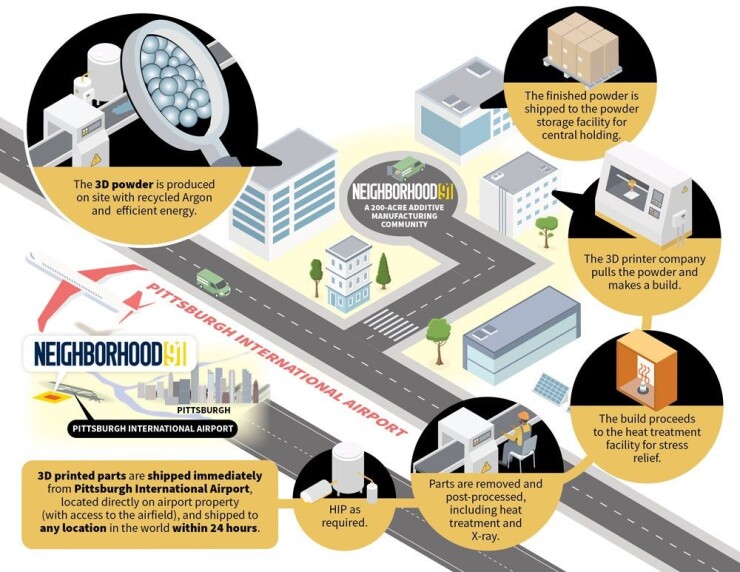Pittsburgh, a former Rust Belt city that's adapting to high-tech, is touting another innovation selling point: additive manufacturing.
Pittsburgh International Airport is planning what it calls the world’s first development to condense and connect all components of the additive manufacturing/3-D printing supply chain into one cluster.

The University of Pittsburgh is a partner for the project. Officials from the Allegheny County Airport Authority, which runs the airport, cited the university’s dual strengths of applied additive manufacturing and supply chain research in addition to pilot programs.
The development, called Neighborhood 91, derives its name from Pittsburgh’s 90 neighborhoods, with this undertaking the 91st. Construction will begin next year. The airport, which serves 9 million passengers annually, sits 18 miles west of downtown.
"Having a key partner like the University of Pittsburgh is key to the success of Neighborhood 91," said David Fiorenza, a public finance professor at Villanova School of Business. "Universities bring the knowledge and economic and financial analysis to assist in completing the project and attracting other tenants to the site.
"It's a natural fit for western Pennsylvania and its location can draw from surrounding states."
It is the first development of the 195-acre Pittsburgh airport innovation campus and will go up next to the airport terminal and runway. Argon gas supplier Arencibia has committed to be the anchor tenant.
The Neighborhood 91 concept is based on shared capital resources at the core of the development, airport officials said.
It will house an end-to-end ecosystem offering: powder, parts, post-production, testing and analysis; communal powder storage facilities; efficiencies in production/post-production and delivery; cost savings for tenants’ clients from on-demand printing; reduced transportation costs; airport access; and argon, helium and other noble gases — essential elements of additive manufacturing — reaching up to 60% of additive manufacturing costs.
“The Pittsburgh region has always been a world leader in manufacturing,” said Allegheny County Executive Rich Fitzgerald.
"Now that industry has evolved into additive manufacturing and 3-D printing, and through Neighborhood 91, we have laid the groundwork to become the global epicenter," he said. "Just as important is leveraging our region’s universities, which will provide necessary research and development and fuel the workforce to the fill these jobs.”
Louisville has been home to a joint workforce-economic development venture with UPS since 1998. The package delivery conglomerate and several parties founded Metropolitan College, a public-private partnership that helped induce UPS to remain in Kentucky. UPS expanded its overnight air hub, Worldport, at Louisville Muhammad Ali International Airport.
Metro College arose through the efforts of the University of Louisville, Jefferson Community & Technical College, and metro and state governments in addition to UPS.
Moody's Investors Service assigns an A2 rating to Allegheny County Airport Authority's general airport revenue bond rating. The authority also runs the county airport in West Mifflin, 12 miles south of Pittsburgh.
Moody's said it expects the authority to succeed in its $1.1 billion terminal modernization project at Pittsburgh International while minimizing disruptions. The airport's declining cost structure, positive enplanement trend and increasingly competitive cost per enplanement further supports the credit, according to Moody's.
"[The airport] benefits from a solid competitive position with no competition in the Pittsburgh metro area and a diverse carrier base, as well as additional non-operating revenue sources from gas drilling royalty revenue, state gaming act revenue and passenger and customer facility charges," Moody's said.
Pittsburgh, on the brink of bankruptcy in 2003 when its bonds were junk, has
Last year the city, which has received 11 rating-agency upgrades since 2003, ended its 14-year stay in the state-sponsored workout program for distressed cities commonly known as Act 47.
Pittsburgh of late has also been at the epicenter of
"Pittsburgh will be stronger in the future due to Neighborhood 91," said Fiorenza, a former chief financial officer of Radnor County, outside Philadelphia. "This type of project would not have happened a decade or two ago when the city was in receivership."
As part of Neighborhood 91, the airport intends to construct a second microgrid to power the development, Its first microgrid to power the terminals and airfield is under development.
Officials estimated that manufacturing lead times will shrink by 80% and transportation costs will shrink by even more.





